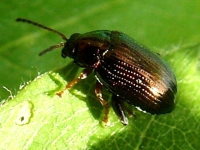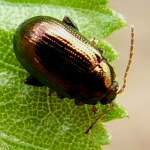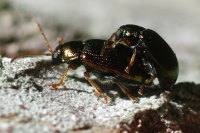Phylum Arthropoda (Arthropods) ➔ Subphylum Hexapoda (Hexapods) ➔ Class Insecta (Insects) ➔ Order Coleoptera (Beetles) ➔ Family Chrysomelidae (Leaf beetles)
Crepidodera aurea (Geoffroy, 1785)
Goldener Erdfloh
Synonyms and other combinations:
Altica aurea Geoffroy, 1785 | Chrysomela cyanea Marsham, 1802 | Haltica gaudens Stephens, 1831 | Haltica metallica Duftschmidt, 1825 |
Classification:
Crepidodera aurea belongs to the subfamily Galerucinae, tribe Alticini.Distribution:
Europe, east to east Siberia.Habitat:
Brook floodplains, forest edges.Description:
Length 2.5 - 3.8 mm; body metallic red gold, copper red, ore brown, golden green, green, blue or violet; pronotum ± strong, mostly unevenly dotted; pronotum points mostly strong, but not conspicuously coarse and deep, mostly less crowded and scattered, mixed with very fine, strongly contrastive points; transverse impression of pronotum rather flat, sometimes as fine narrow furrow, sometimes almost diminished, often slightly bent backwards.Crepidodera aurea is built slightly wider than the similar, smaller Crepidodera fulvicornis.
Biology:
Crepidodera aurea is a macropterous and airworthy species that forms one generation per year. The imagines can be found on their host plants from May to October (with peaks in early June and mid September). They live oligophagously on plants of the willow family (Salicaceae), especially on poplars [aspen (Populus tremula), black poplar (Populus nigra) and white poplar (Populus alba)], less frequently on willows [goat willow (Salix caprea ) and grey willow (Salix cinerea)].Crepidodera aurea hibernates as an imago. After a maturation feeding, the eggs are laid. The larvae develop in summer and live on the roots of their host plants. The new beetle generation can be found outside from late summer.
References, further reading, links:
- Rheinheimer, Joachim, & Hassler, Michael: Die Blattkäfer Baden-Württembergs, 2018, 928 pages, Kleinsteuber Books (Karlsruhe), ISBN 978-3-9818110-2-5
- Arved Lompe: Die Käfer Europas - Ein Bestimmungswerk im Internet
- Altica sp.
- Bruchus sp.
- Cassida nebulosa
- Cassida sp.
- Cassida stigmatica
- Cassida vibex
- Cassida vibex/bergeali
- Chrysolina lucidicollis
- Chrysolina oricalcia
- Chrysolina sp.
- Chrysolina sturmi
- Chrysolina varians
- Chrysomela tremula
- Coptocephala sp.
- Crepidodera aurea
- Crepidodera fulvicornis
- Cryptocephalus moraei
- Cryptocephalus nitidus
- Cryptocephalus pusillus
- Cryptocephalus sp.
- Donacia cinerea
- Donacia marginata
- Donacia versicolorea
- Galeruca tanaceti
- Galerucella s.l.
- Gonioctena decemnotata
- Gonioctena quinquepunctata
- Gonioctena sp.
- Gonioctena viminalis
- Lema cyanella
- Neocrepidodera sp.
- Oulema melanopus/duftschmidi
- Oulema obscura
- Pachybrachis sp.
- Phratora sp.
- Plagiosterna aenea
- Plateumaris sp.
- Podagrica fuscicornis
- Psylliodes sp.
- Sphaeroderma sp.
- Gonioctena quinquepunctata/intermedia
- Alder Leaf Beetle
- Ant Bag Beetle
- Barley Flea Beetle
- Brassy Willow Leaf Beetle
- Broad Bean Weevil
- Case-bearing Leaf Beetles
- Colorado Potato Beetle
- Dead-nettle Leaf Beetle
- Elm Leaf Beetle
- Four Spotted Leaf Beetle
- Green Dock Beetle
- Green Tortoise Beetle
- Horseradish Flea Beetle
- Imported Willow Leaf Beetle
- Iris Flea Beetle
- Lily Leaf Beetle
- Plantain Leaf Beetle
- Poplar Leaf Beetle
- Skullcap Leaf Beetle
- Spotted Asparagus Beetle
- Spotted Willow Leaf Beetle
- St John's-wort Leaf Beetle
- Thistle Tortoise Beetle
- Turnip Flea Beetle
- Two-tone Reed Beetle
- Viburnum Leaf Beetle
- Western Grape Rootworm
- Wheat Flea Beetle
- Willow Flea Beetle
- Willow Leaf Beetle



